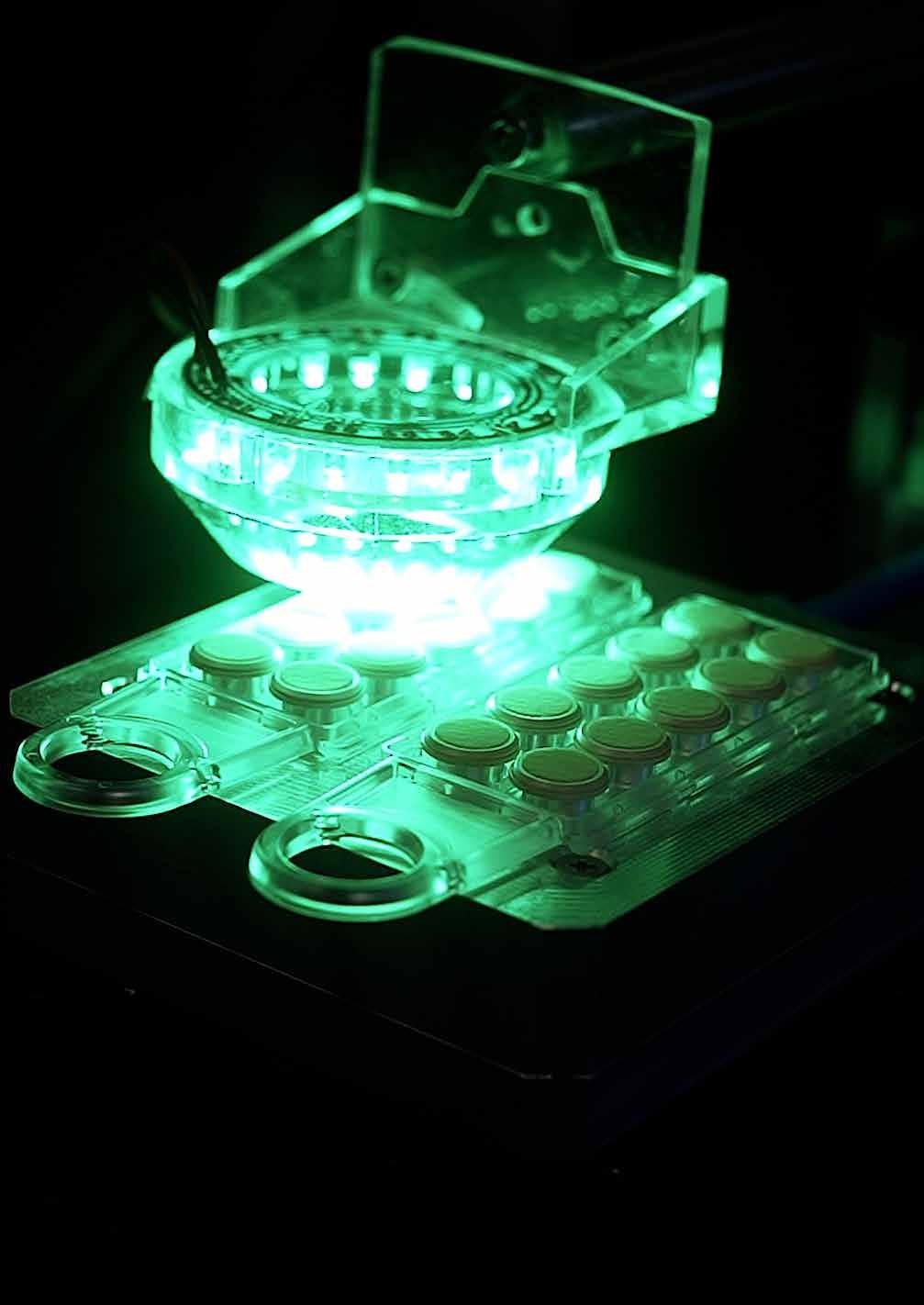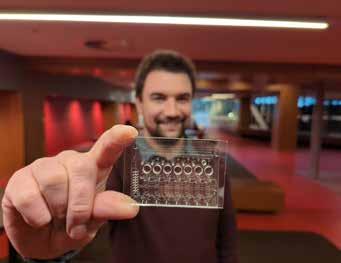
7 minute read
RMIT and Vaxxas open innovative med-tech manufacturing facilities this year.
from AMT AUG/SEP 2023
by AMTIL
RMIT University’s Discovery to Device facility opens this September in Melbourne and Vaxxas opened its advanced manufacturing facility this June in Brisbane. Carole Goldsmith reports.
RMIT University’s exciting Discovery to Device (D2D) advanced manufacturing facility will open this September at its city campus in Melbourne. The $16.7m Victorian Medical Device Prototyping and Scale–Up facility will enable entrepreneur start-up manufacturers and researchers to work together to develop new medical technologies for healthcare and diagnostics.
Earlier this year, Victorian Minister for Higher Education, Gayle Tierney announced $12.7m in funding from the Victorian Higher Education State Investment Fund (VHESIF) for RMIT’s new facility. D2D Director, Professor Sharath Sriram says that this complex will be the first ISO-accredited prototyping facility in the Asia-Pacific to support rapid translation of partnered and industry-led research projects in wearable, nearable and flexible medical technologies. It will also follow the ISO 13485 standard used in the design and production of medical devices. The facility will be available for universities and industry across Victoria for collaborations on wearables (wireless electronic devices that can be worn as accessories, embedded in clothing or implanted in the body), nearables (smart devices that can sense and send data but don’t need to be attached to a person) and point-of-care diagnostics (rapid screening for diseases).
“RMIT has core central facilities as well as the new D2D building,” advises Prof. Sriram. “At the existing core space, researchers conduct micro/nano-fabrication, additive/subtractive printing and materials’ characterisation. These were combined recently under a common ‘brand’ known as the Advanced Manufacturing Precinct.
“The existing facilities are for R&D in the early-stage discovery work. The Micro Nano Research Facility (MNRF) which opened in 2016, is where we test ideas and develop prototypes of different medical devices for our SMEs and start- up clients. When the D2D facility is operational, larger numbers of these prototypes will be made through manufacturing scale-up and we will be accelerating medtech commercialisation. With fit out of the new facility completed in July, all equipment is being installed between July and September this year.”
“The three-core staff of the D2D Facility have already started work,” adds Prof. Sriram. “The Technical Coordinator handles facility operations and compliance with ISO accreditation documents. There are two technical officers, one is specialised in device fabrication and biosensing and the other is skilled in flexible electronics integration and packaging.
“Industry partners will be assisted by experienced research leaders. These key researchers will be supported by a group of 16 research fellows as well as PhD students to assist in problem solving for industry clients.” He stresses that as well as working on medical devices’ R&D and commercialisation, they will be covering other industry sectors as well.
Discovery to device facility layout
Prof. Sriram describes some of the installations and advanced manufacturing equipment planned for the new 400sqmtr D2D facility. “There’ll be a Class 1,000 (ISO 6) cleanroom environment for fabrication of biosensors, nanoscale patterning and deposition of thin film coatings for functionalisation and electronic interfacing. We’ll also install specialised equipment to enable micro-machining of skin mounted wearables and biocompatible materials for devices’ packaging.”
The D2D will house a class 10,000 (ISO 7) semiconductor clean room environment operating under ISO 13485 protocols (as required for medical devices’ manufacturing). This enables rapid throughput production of ultra-light flexible electronics’ circuits and advanced laser-based electronics prototyping. The facilities will also include state-of-the-art capabilities to characterise biosensors, which are systems or devices that can analyse biological samples.
Micro Nano Research Facility
Prof. Sriram invited AMT to view a range of the med-tech device prototypes being produced at the MNRF. These labs cover patterning of devices, ultra-thin and pure functional coatings and creation of stretchable electronics and microfluidic devices.
“Here at the MNRF we make devices which use electronics, photons (light) or microfluids. Our researchers discuss the start-up client’s ideas for a device and we work together to develop the design and make the prototype.
Continued next page
Continued from previous page
“Interested larger manufacturers usually want a minimum order quantity, the cost of which start-ups and SMEs cannot bear. So, the D2D prototyping facility, where we can make a few thousands of the product, will bridge that gap and you can then run clinical trials and field trials. We will also connect start-ups with product design firms and regulatory experts. With a lot of start-ups, navigating the ecosystem to understand it all, is often very difficult for them, so our aim is to assist them to get their product to market.”
He points to a selection of devices in the display cabinet that have been developed at the MNRF. Prof. Sriram holds a gas sensing capsule which looks like a vitamin capsule. He explains that it’s like a ‘pillcam’ which can be swallowed and an internal image taken. This pillcam measures stomach gases and food intolerance. It started as a research project to study human stomach gases, however the first funding the MNRF received for its R&D was from the Department of Agriculture to measure the influence of the cow’s diet and their methane expulsion. A Melbourne based start-up called Atmo Biosciences, is licensing the gas sensing capsule technology from RMIT. They are doing late-stage clinical trials now and hopefully this product can be commercialised in the near future.
Prof. Sriram displays a microfluidic device which is used for antiplatelet drug screening. He explains that the same fluid goes through the seven small channels on the plastic device and compares the differences in performance with seven different drugs.

“We are also working with the Melbourne company Sleeptite, which makes innovative products for aged care,” he says. “We adhere these electronic wires to bedding material, which can heat up the bed. It can also set up alerts to aged care personal, if a person is on the edge of a bed, at risk of falling, or if they have stopped breathing.”
He adds that he and his team have been actively engaged with many manufacturers and product design firms. Together they are assisting smaller companies to develop their med tech ideas into products. The D2D project consortium, which is led by RMIT University, includes universities, (Swinburne, Deakin and Monash), industry partners (Sleeptite, Nutromics, Soterius, Vlepis, nthalmic, Innovative Manufacturing CRC), quality management and design partners (Pharmalex/Brandwood CKC, Fluffy Spider Technologies, outerspace Design, Design +Industry) and peak bodies (Advanced Manufacturing Growth Centre, Cooperative Research Centre and MTP Connect).
“We are very excited about the future, bringing together researchers and start-ups, SMEs, larger manufacturers and designers to collaborate on R&D, prototype development, then later in field and clinical trials. Then we’ll move forward to regulatory certification and commercialisation of innovative medical devices,” Prof.Sriram says.
Vaxxas Biomedical Facility now open
Clinical-stage biotechnology company Vaxxas, in partnership with the Queensland Government, opened its global headquarters and state-of-the-art manufacturing facility this June 19 in Brisbane.

The custom-built 5,500m² (60,000 square feet) Vaxxas Biomedical Facility is a first-of-its-kind manufacturing site, designed to support the scale-up of Vaxxas’ needle-free vaccine technology platform, the high-density microarray patch (HD-MAP), for late-stage clinical trials and first commercial products.
AMT magazine spoke to Vaxxas’ Chief Technology Officer, Dr. Angus Forster, the day after the new facility opened. “It’s been an exciting couple of weeks and it was an excellent day yesterday. Queensland’s Deputy Premier, Dr Steven Miles opened the facility and we had around 80 invited guests from industry in attendance.”
Vaxxas’ new facility is located in Brisbane’s Northshore and the company was previously based at the Translational Research Institute (TRI) at the Princess Alexandra Hospital Campus in Brisbane’s inner suburbs.
“We are still keeping a presence at the TRI for its pre-clinical infrastructure, while our new facility is focused on manufacturing our vaccine patches for late-stage clinical trials and commercial product. It's great to still be connected with the vibrant TRI research community, as there are many immunology scientists and physicians working there. Vaxxas also had a small manufacturing engineering facility located further south of the city and this has been transferred to the new facility.”
Dr. Forster was Vaxxas’ first employee, when he joined the company over 11 years ago as Vice President of R&D and he has been in his current role for 1.5 years. “Vaxxas now employs more than 130 staff. We’re also very excited that we’ve appointed industry veteran and Pfizer’s former senior medical leader, Dr. Rochelle Chaiken, as our new Chief Medical Officer (CMO). Previously she was CMO for Pfizer’s Biopharmaceutical Group for Emerging Markets, which included the rollout of the Pfizer Comirnaty mRNA COVID vaccine. “Vaxxas has recruited a significant number of scientists, trained in biochemistry, biology and medicinal chemistry, to support our vaccine development programs. Engineers skilled in pharmaceutical and medical device industrialisation have also joined the company, along with experts in the pharmaceutical regulatory and quality areas which are critical to our progress through to commercialisation.”
The Vaxxas Biomedical Facility has office areas, laboratories for R&D and quality control testing as well as engineering development space for testing various aspects of the HD-MAP technology and the device components of the patch applicator.
“The major benefit of the facility is that it has space to do our manufacturing, both on the device side making patches and applicators, but also producing finished vaccine products in cleanrooms,” says Dr. Forster. “That’s very exciting as we will be able to make product for Phase II and Phase III clinical trials and eventually for commercialisation here, although that is a few years away.”
“There's two parts of the device technology. The patch itself, which is manufactured with thousands of micro projections that are ultimately printed with vaccine. This then goes into an applicator device, which applies the patch with the vaccine to just under the surface of the skin. In our new facility, we can manufacture those individual components on a large scale. We need to be audited and certified with a licence from the Therapeutic Goods Administration (TGA) to manufacture in Australia.
“This facility will enable us to prepare for that first TGA audit and licence. Then we can supply products into Phase II and Phase III clinical trials. Down the track, with further regulatory approvals, we can move into commercial manufacturing. This facility is built to meet the TGA’s requirements as well as those of the US FDA and the European Medicines Agency (EMA).”
Vaxxas has six clinical programs underway with various vaccines and partners. Among these programs, the Vaxxas HD-MAP is currently







